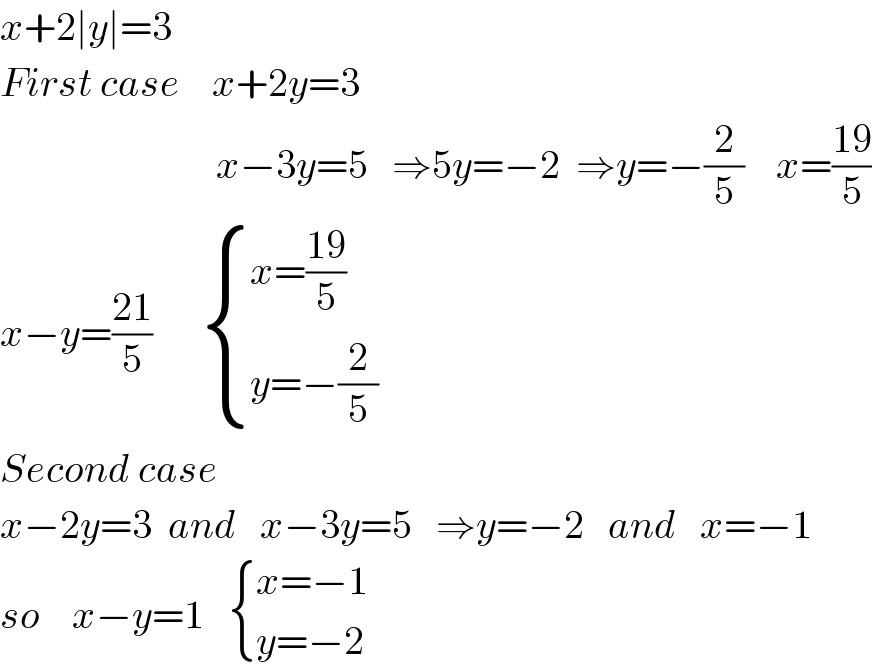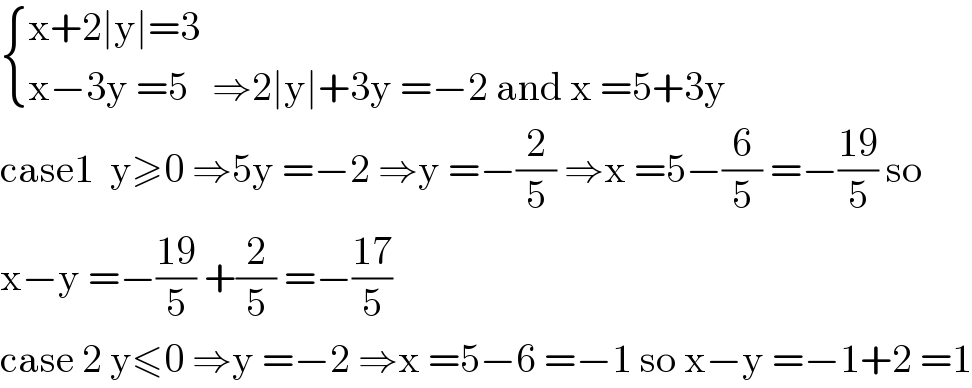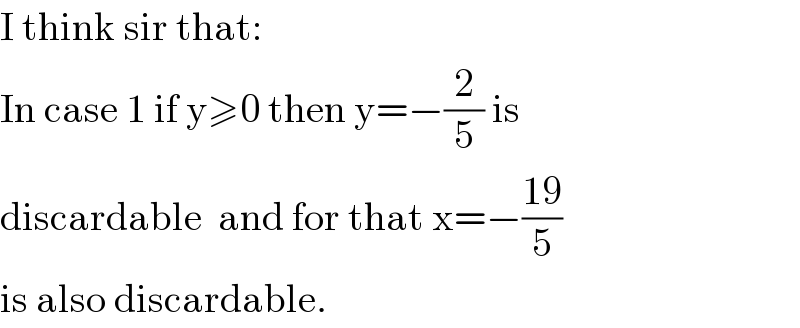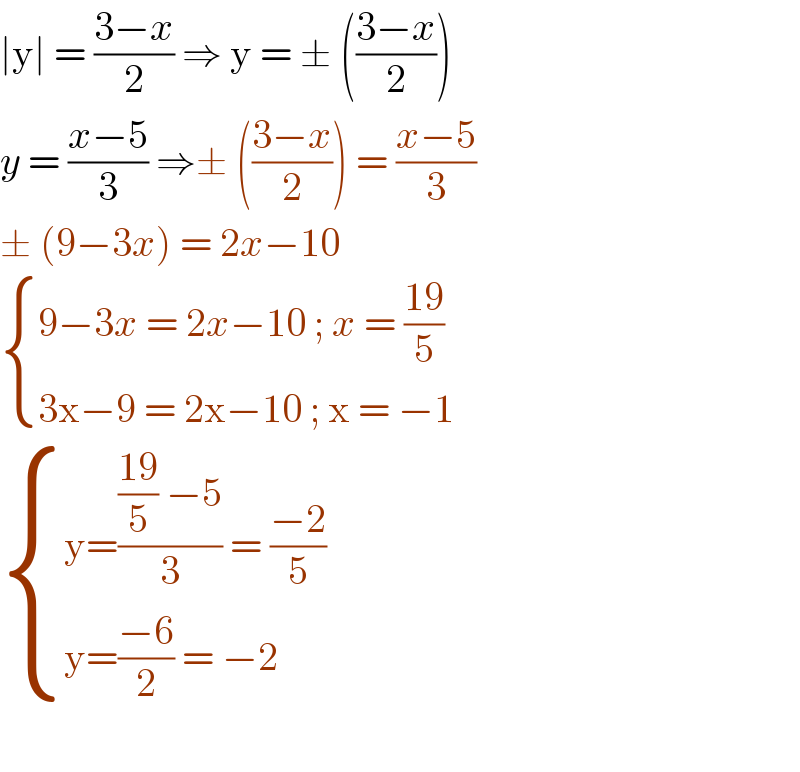Question Number 100597 by bobhans last updated on 27/Jun/20

Commented by Dwaipayan Shikari last updated on 27/Jun/20

$${x}+\mathrm{2}\mid{y}\mid=\mathrm{3} \\ $$$${First}\:{case}\:\:\:\:{x}+\mathrm{2}{y}=\mathrm{3} \\ $$$$\:\:\:\:\:\:\:\:\:\:\:\:\:\:\:\:\:\:\:\:\:\:\:\:\:\:\:{x}−\mathrm{3}{y}=\mathrm{5}\:\:\:\Rightarrow\mathrm{5}{y}=−\mathrm{2}\:\:\Rightarrow{y}=−\frac{\mathrm{2}}{\mathrm{5}}\:\:\:\:{x}=\frac{\mathrm{19}}{\mathrm{5}} \\ $$$${x}−{y}=\frac{\mathrm{21}}{\mathrm{5}}\:\:\:\:\:\:\begin{cases}{{x}=\frac{\mathrm{19}}{\mathrm{5}}}\\{{y}=−\frac{\mathrm{2}}{\mathrm{5}}}\end{cases} \\ $$$${Second}\:{case} \\ $$$${x}−\mathrm{2}{y}=\mathrm{3}\:\:{and}\:\:\:{x}−\mathrm{3}{y}=\mathrm{5}\:\:\:\Rightarrow{y}=−\mathrm{2}\:\:\:{and}\:\:\:{x}=−\mathrm{1} \\ $$$${so}\:\:\:\:{x}−{y}=\mathrm{1}\:\:\:\begin{cases}{{x}=−\mathrm{1}}\\{{y}=−\mathrm{2}}\end{cases} \\ $$
Answered by mathmax by abdo last updated on 27/Jun/20

$$\begin{cases}{\mathrm{x}+\mathrm{2}\mid\mathrm{y}\mid=\mathrm{3}}\\{\mathrm{x}−\mathrm{3y}\:=\mathrm{5}\:\:\:\Rightarrow\mathrm{2}\mid\mathrm{y}\mid+\mathrm{3y}\:=−\mathrm{2}\:\mathrm{and}\:\mathrm{x}\:=\mathrm{5}+\mathrm{3y}}\end{cases} \\ $$$$\mathrm{case1}\:\:\mathrm{y}\geqslant\mathrm{0}\:\Rightarrow\mathrm{5y}\:=−\mathrm{2}\:\Rightarrow\mathrm{y}\:=−\frac{\mathrm{2}}{\mathrm{5}}\:\Rightarrow\mathrm{x}\:=\mathrm{5}−\frac{\mathrm{6}}{\mathrm{5}}\:=−\frac{\mathrm{19}}{\mathrm{5}}\:\mathrm{so} \\ $$$$\mathrm{x}−\mathrm{y}\:=−\frac{\mathrm{19}}{\mathrm{5}}\:+\frac{\mathrm{2}}{\mathrm{5}}\:=−\frac{\mathrm{17}}{\mathrm{5}} \\ $$$$\mathrm{case}\:\mathrm{2}\:\mathrm{y}\leqslant\mathrm{0}\:\Rightarrow\mathrm{y}\:=−\mathrm{2}\:\Rightarrow\mathrm{x}\:=\mathrm{5}−\mathrm{6}\:=−\mathrm{1}\:\mathrm{so}\:\mathrm{x}−\mathrm{y}\:=−\mathrm{1}+\mathrm{2}\:=\mathrm{1} \\ $$
Commented by Rasheed.Sindhi last updated on 27/Jun/20

$$\mathrm{I}\:\mathrm{think}\:\mathrm{sir}\:\mathrm{that}: \\ $$$$\mathrm{In}\:\mathrm{case}\:\mathrm{1}\:\mathrm{if}\:\mathrm{y}\geqslant\mathrm{0}\:\mathrm{then}\:\mathrm{y}=−\frac{\mathrm{2}}{\mathrm{5}}\:\mathrm{is} \\ $$$$\mathrm{discardable}\:\:\mathrm{and}\:\mathrm{for}\:\mathrm{that}\:\mathrm{x}=−\frac{\mathrm{19}}{\mathrm{5}} \\ $$$$\mathrm{is}\:\mathrm{also}\:\mathrm{discardable}. \\ $$
Answered by john santu last updated on 27/Jun/20

$$\mid\mathrm{y}\mid\:=\:\frac{\mathrm{3}−{x}}{\mathrm{2}}\:\Rightarrow\:\mathrm{y}\:=\:\pm\:\left(\frac{\mathrm{3}−{x}}{\mathrm{2}}\right) \\ $$$${y}\:=\:\frac{{x}−\mathrm{5}}{\mathrm{3}}\:\Rightarrow\pm\:\left(\frac{\mathrm{3}−{x}}{\mathrm{2}}\right)\:=\:\frac{{x}−\mathrm{5}}{\mathrm{3}} \\ $$$$\pm\:\left(\mathrm{9}−\mathrm{3}{x}\right)\:=\:\mathrm{2}{x}−\mathrm{10} \\ $$$$\begin{cases}{\mathrm{9}−\mathrm{3}{x}\:=\:\mathrm{2}{x}−\mathrm{10}\:;\:{x}\:=\:\frac{\mathrm{19}}{\mathrm{5}}}\\{\mathrm{3x}−\mathrm{9}\:=\:\mathrm{2x}−\mathrm{10}\:;\:\mathrm{x}\:=\:−\mathrm{1}\:}\end{cases} \\ $$$$\begin{cases}{\mathrm{y}=\frac{\frac{\mathrm{19}}{\mathrm{5}}\:−\mathrm{5}}{\mathrm{3}}\:=\:\frac{−\mathrm{2}}{\mathrm{5}}}\\{\mathrm{y}=\frac{−\mathrm{6}}{\mathrm{2}}\:=\:−\mathrm{2}}\end{cases} \\ $$$$ \\ $$
